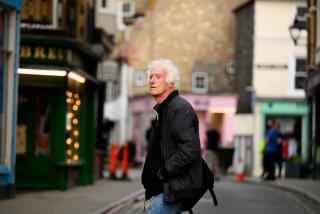A ‘time-lapse’ chronicle of a rapidly changing China
- Share via
WHEN Stephen Wilkes first visited China in 1978 as a Syracuse University student, the New York native had an inkling the country was in for changes. It was two years after the death of Chairman Mao Tse-tung, post-Cultural Revolution. And though Wilkes was right, he didn’t realize the extreme degree of the transformation that he’d be chronicling almost three decades later.
“I never would have imagined that one of the oldest cultures in history would change as radically as it had,” he says. “It’s like watching a time-lapse movie.” The results of his four recent follow-up trips -- 17 images of landscapes and individuals -- are on display in the new exhibition “Stephen Wilkes: China” at the David Gallery in Culver City.
Wilkes traveled all over China, from megalopolises such as Beijing and Shanghai, to more modest (but still large) cities such as Changsha and Guilin, attempting to capture old China’s coexistence with new China. Along with traditional pastorals, there are long shots of elaborate factories. “China’s moving away from being a farming society and putting more weight on manufacturing,” Wilkes says. “I’d heard the factories were as big as American football fields.”
Wilkes got to see this firsthand. Through his connections as a commercial photographer for clients such as IBM, Perrier and Nike, the artist was able to arrange to shoot one of the shoe company’s factories. “They have 20,000 people making sneakers at one time. It was like a city within a city,” he explains, injecting his own cultural reference point into the description: “When they break for lunch at 11:30, it looks like Yankee Stadium being emptied in the fifth inning.”
Another image, “Boy in Beijing,” hints at the rising arts scene that has developed alongside industrialization; it shows a boy inside the 798 Space, a former factory designed by East German architects in the 1950s that now serves as an avant-garde gallery.
For Wilkes, known for his Ellis Island project chronicling the deteriorated south side of the immigrant landing pad, the foray has been journalistic and personal. He hopes to share his humanistic take on China’s growth with Americans who might perceive the country’s factory laborers as robots in an assembly-line process.
The very tangible price of such growth can be seen in his “before and after” shots of a farming community, which the government had decided to turn into manufacturing facilities. “I did a portrait of a family at twilight, not knowing that it was going to be the last night they spent at their house,” he says. “I came back a few days later and the house was gone.”
Much like China’s race to advancement, Wilkes’ project is a work in progress; he plans to continue chronicling the changes there, as well as this summer’s Beijing Olympics. “My hope,” he says, “is that China can find balance.”
--
--
STEPHEN WILKES: CHINA
WHERE: David Gallery, 5797 Washington Blvd., Culver City
WHEN: 11 a.m. to 6 p.m. Tuesdays to Saturdays; ends March. 22
PRICE: Free
INFO: (323) 939-9069, www.davidgallery.net
More to Read
The biggest entertainment stories
Get our big stories about Hollywood, film, television, music, arts, culture and more right in your inbox as soon as they publish.
You may occasionally receive promotional content from the Los Angeles Times.










